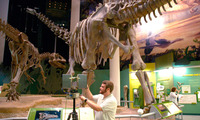 It’s been the fantasy of many kids (and adults) to recreate dinosaurs. Those almost mythical, but real beasts from prehistoric times challenge our curiosity. What were they really like. Probably they’d eat you if they had a chance, but is there a way to rebuild the dinosaurs? The late author Michael Crichton proposed doing so with biotech and DNA, but as we all know, that didn’t work out too well.
It’s been the fantasy of many kids (and adults) to recreate dinosaurs. Those almost mythical, but real beasts from prehistoric times challenge our curiosity. What were they really like. Probably they’d eat you if they had a chance, but is there a way to rebuild the dinosaurs? The late author Michael Crichton proposed doing so with biotech and DNA, but as we all know, that didn’t work out too well. Now there’s a much safer and feasible way to bring back the dinosaurs: 3D printing. The Institute of Industrial Engineers reports on a fantastic project to recreate a skeletal Apatosaurus. Typically prehistoric remains are damaged, incomplete and fragile, a scenario just dying to be rectified by 3D technology.
Palaeontologists from the University of Oklahoma joined with the Center for Shape Engineering and Advanced Manufacturing to develop and implement a new approach for makin’ bones. They used high-powered 3D scanners from FARO to capture complete digital information about the existing bone material, and then “cleaned them up” using 3D modeling software. For example, missing limbs could be recreated by replicating a mirror image of the corresponding bone from the other side of the body. Finally, the repaired 3D models were 3D printed.
But were these 3D prints them put on display? No! They were used to create molds from which many copies of the skeleton could be born.


What's even more awesome than making dinosaurs using 3d-printing technology. Why, making really cool pet id tags of course. Flash Gordon 3d-printed Pet ID Tags